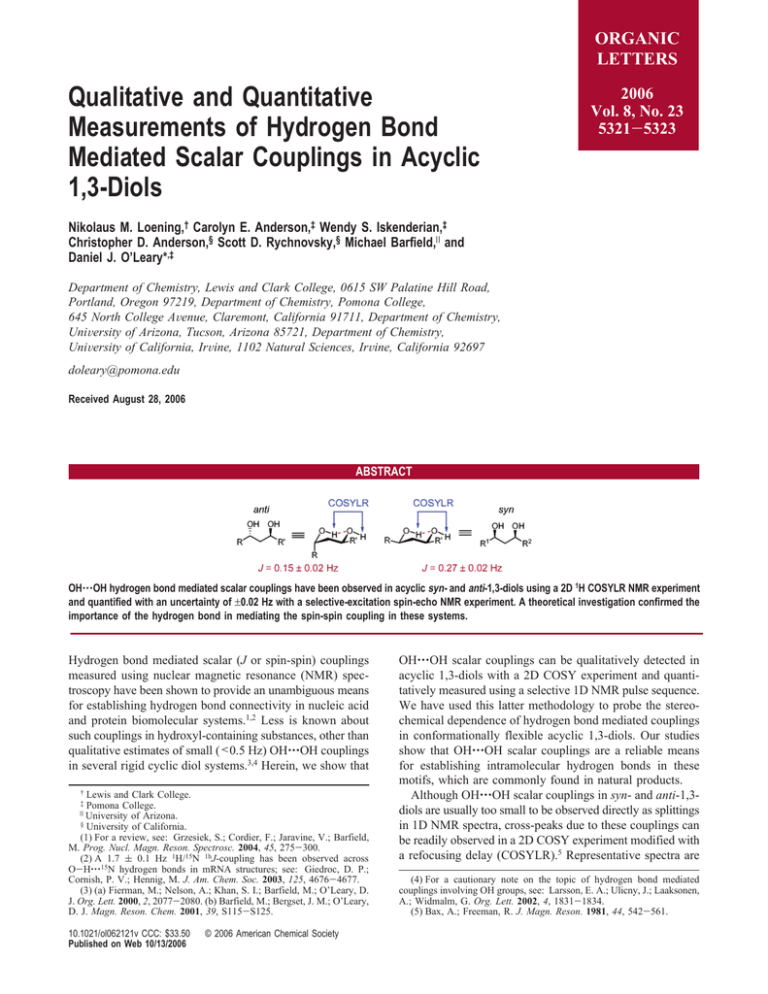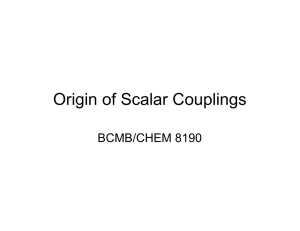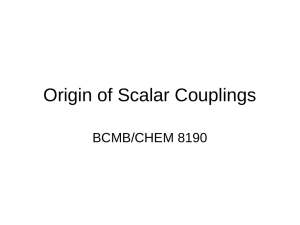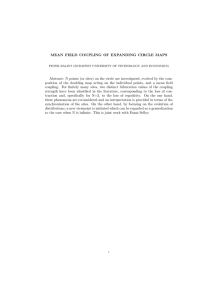Qualitative and Quantitative Measurements of Hydrogen Bond Mediated Scalar Couplings in Acyclic 1,3-Diols
advertisement

ORGANIC LETTERS Qualitative and Quantitative Measurements of Hydrogen Bond Mediated Scalar Couplings in Acyclic 1,3-Diols 2006 Vol. 8, No. 23 5321-5323 Nikolaus M. Loening,† Carolyn E. Anderson,‡ Wendy S. Iskenderian,‡ Christopher D. Anderson,§ Scott D. Rychnovsky,§ Michael Barfield,| and Daniel J. O’Leary*,‡ Department of Chemistry, Lewis and Clark College, 0615 SW Palatine Hill Road, Portland, Oregon 97219, Department of Chemistry, Pomona College, 645 North College AVenue, Claremont, California 91711, Department of Chemistry, UniVersity of Arizona, Tucson, Arizona 85721, Department of Chemistry, UniVersity of California, IrVine, 1102 Natural Sciences, IrVine, California 92697 doleary@pomona.edu Received August 28, 2006 ABSTRACT OH‚‚‚OH hydrogen bond mediated scalar couplings have been observed in acyclic syn- and anti-1,3-diols using a 2D 1H COSYLR NMR experiment and quantified with an uncertainty of ±0.02 Hz with a selective-excitation spin-echo NMR experiment. A theoretical investigation confirmed the importance of the hydrogen bond in mediating the spin-spin coupling in these systems. Hydrogen bond mediated scalar (J or spin-spin) couplings measured using nuclear magnetic resonance (NMR) spectroscopy have been shown to provide an unambiguous means for establishing hydrogen bond connectivity in nucleic acid and protein biomolecular systems.1,2 Less is known about such couplings in hydroxyl-containing substances, other than qualitative estimates of small (<0.5 Hz) OH‚‚‚OH couplings in several rigid cyclic diol systems.3,4 Herein, we show that † Lewis and Clark College. Pomona College. University of Arizona. § University of California. (1) For a review, see: Grzesiek, S.; Cordier, F.; Jaravine, V.; Barfield, M. Prog. Nucl. Magn. Reson. Spectrosc. 2004, 45, 275-300. (2) A 1.7 ( 0.1 Hz 1H/15N 1hJ-coupling has been observed across O-H‚‚‚15N hydrogen bonds in mRNA structures; see: Giedroc, D. P.; Cornish, P. V.; Hennig, M. J. Am. Chem. Soc. 2003, 125, 4676-4677. (3) (a) Fierman, M.; Nelson, A.; Khan, S. I.; Barfield, M.; O’Leary, D. J. Org. Lett. 2000, 2, 2077-2080. (b) Barfield, M.; Bergset, J. M.; O’Leary, D. J. Magn. Reson. Chem. 2001, 39, S115-S125. ‡ | 10.1021/ol062121v CCC: $33.50 Published on Web 10/13/2006 © 2006 American Chemical Society OH‚‚‚OH scalar couplings can be qualitatively detected in acyclic 1,3-diols with a 2D COSY experiment and quantitatively measured using a selective 1D NMR pulse sequence. We have used this latter methodology to probe the stereochemical dependence of hydrogen bond mediated couplings in conformationally flexible acyclic 1,3-diols. Our studies show that OH‚‚‚OH scalar couplings are a reliable means for establishing intramolecular hydrogen bonds in these motifs, which are commonly found in natural products. Although OH‚‚‚OH scalar couplings in syn- and anti-1,3diols are usually too small to be observed directly as splittings in 1D NMR spectra, cross-peaks due to these couplings can be readily observed in a 2D COSY experiment modified with a refocusing delay (COSYLR).5 Representative spectra are (4) For a cautionary note on the topic of hydrogen bond mediated couplings involving OH groups, see: Larsson, E. A.; Ulicny, J.; Laaksonen, A.; Widmalm, G. Org. Lett. 2002, 4, 1831-1834. (5) Bax, A.; Freeman, R. J. Magn. Reson. 1981, 44, 542-561. Figure 1. 400 MHz 1H 2D COSYLR data for syn-diol 9 (A; 200 ms delay) and anti-diol 1 (B; 400 ms delay). Off-diagonal cross-peaks correlate OH groups via OH/OH scalar coupling. Note: OH/OH scalar couplings are not resolved in the 1D spectra; OH peaks are doublets due to 3JH-O-C-H. shown in Figure 1. These measurements require sharp hydroxyl resonances free of intermolecular proton exchange. This is readily accomplished by recording spectra with dilute (1-3 mM) samples containing a small quantity of neutral alumina to scavenge soluble exchange catalysts.6 Determining the magnitude of the coupling constant on the basis of the COSYLR experiment, however, is difficult because the intensity of a cross-peak may depend on the relaxation rates and coupling constants of a number of nuclei within the molecule. To circumvent this difficulty, the pulse sequence shown in Figure 2 was used to directly measure OH‚‚‚OH scalar couplings. In this sequence, cosine-modulated Gaussian pulses selectively excite and refocus two spins at a time. Because of the selective nature of the spin-echo, couplings from unselected spins are refocused at time t (the end of the echo); the only evolution during the spin-echo period is due to coupling between the selectively excited spins. This is essential as, otherwise, the myriad of potential long-range couplings makes it difficult to interpret how the peak intensities vary as a function of t. By integrating peaks from a series of experiments with different values of t, we were able to observe the evolution of the magnetization and fit the resulting data to determine the scalar coupling constant. Although it is possible to derive a theoretical equation for the selective spin-echo experiment to describe the variation of the peak integrals for the case of two isolated spins, real systems are somewhat more complicated to fit as the variation will depend on several relaxation times. In practice, it is easier to fit the integrals from each OH peak (S) as a function of the spin-echo time (t) to an exponentially damped cosine function: ( Tt ) cos(πJt) S ) S0 exp - (1) In the fitting process, the initial (t ) 0) peak integral (S0), the empirical decay constant (T), and the scalar coupling 5322 Figure 2. (A) One-dimensional selective spin-echo experiment for measuring small scalar couplings. The z-filter renders antiphase coherences unobservable, thereby ensuring a purely absorptionphase signal.7 (B) Experimental data from diol 3 from a series of selective spin-echo experiments. The integrals of the two OH resonances as a function of the spin-echo time (t) are shown as blue squares and red diamonds; the lines indicate the best fits of the data to eq 1. The shaded regions in the inset graph indicate fits for both resonances with J values ranging from 0.24 to 0.28 Hz. constant (J) are allowed to vary independently. Shown in Figure 2 are the results from a series of selective spin-echo experiments for syn-diol 3. The fit of the data to eq 1 resulted in an estimate of 0.26 ( 0.02 Hz for the coupling constant. The uncertainty is based on the standard deviation in the measured coupling constants from a series of experiments performed at different temperatures and using different delay times. Additionally, the inset graph in Figure 2 illustrates that fits outside of the (0.02 Hz range do not adequately match the zero-crossing (which is entirely due to the cosine term in eq 1).8 For compounds where zero-crossings were not observed, we report the maximum coupling constant, consistent with our observations (diols 6 and 7, for example). (6) Anderson, C. E.; Britt, D. K.; Sangji, S.; O’Leary, D. J.; Anderson, C. D.; Rychnovsky, S. D. Org. Lett. 2005, 7, 5721-5723. (7) Thrippleton, M. J.; Keeler, J. Angew. Chem., Int. Ed. 2003, 42, 39383941. (8) Elaborate ways to more accurately include relaxation in the damping of the signal can be derived, but such approaches are fraught with uncertainties because of the multiple relaxation times involved and the susceptibility of such analyses to experimental artifacts. Consequently, in fitting the data, we focus on the sinusoidal component due to the coupling constant and lump all other relaxation and experimental artifacts together as a single exponential damping term. By focusing on where the signal changes sign (which can only be due to the coupling term), we sidestep the problem of trying to define multiple relaxation terms and are able to accurately extract the coupling constant. Org. Lett., Vol. 8, No. 23, 2006 Table 1. Selected syn- and anti-2,4-Pentanediol Conformations and Their Partial Mole Fractions (x) at 298 K Based Upon MP2/6-311G(d,p) Relative Energies Using a Polarizable Continuum Model (PCM, CH2Cl2)a Figure 3. OH‚‚‚OH scalar couplings ((0.02 Hz) in anti- and synpolyacetate and polypropionate model compounds and triol 10, measured from 300 MHz 1H NMR spectra using the pulse sequence shown in Figure 2. Experimental results are compiled in Figure 3 for a number of diols and one triol sample. The polyacetate data show that 1,3-syn isomer 3 can be distinguished from 1,3-anti isomers 1 and 2 by its larger coupling constant (0.26 vs 0.16 and 0.15 Hz). Among polypropionates, the 1,3-syn- (1,2anti-) diols 8 and 9 gave coupling constants (0.25, 0.33 Hz) comparable with the syn-diacetate 3. However, 1,3-synpolypropionates 6 and 7 bearing the 1,2-syn stereochemistry were found to have a reduced coupling constant (<0.17, <0.15 Hz) compared to all other syn-diols. Likewise, 1,3anti-polypropionates 4 and 5 also exhibited reduced coupling constants (0.18, 0.20 Hz). The coupling constants are measurably larger in triol 10, where the interacting 1,4- and 1,3-OH groups have fewer degrees of freedom and are in closer proximity than in the acyclic examples. Calculations identified several factors that affect the magnitude of OH‚‚‚OH coupling constants in syn- and anti2,4-pentanediol (Table 1). First, the computed mole fraction of conformations containing intramolecular hydrogen bonds was found to be greater for the syn isomer (xsyn ) 0.94, xanti ) 0.66).9,10 This compositional difference is important because the couplings tend to be dominated by the Fermi contact (FC) mechanism, which is largest in conformations containing intramolecular hydrogen bonds (e.g., compare conformer 12e with 12a-d). Two additional issues involve (i) the number of unique hydrogen-bonded conformations (more for the anti stereoisomer) and (ii) the sign of the coupling constant. The experimental value is therefore predicted to arise from a weighted average of terms of opposite sign. Because the conformer populations were found (9) Details of the calculations are provided in the Supporting Information. (10) This result is consistent with an NMR analysis performed in CH2Cl2; see: Fukuroi, T.; Fujiwara, Y.; Fujiwara, S. Anal. Chem. 1968, 40, 879-889. Org. Lett., Vol. 8, No. 23, 2006 syn entry x 11a 11b 0.61 0.33b 2hJ FC (Hz) -0.32 +0.21 anti entry x 12a 12b 12c 12d 12e 0.09 0.18 0.19 0.07 0.12c 2hJ FC (Hz) -0.66 +0.22 -0.57 +0.16 -0.002 aFermi contact term of the OH‚‚‚OH coupling constant (2hJ ) computed FC with (PCM, CH2Cl2) UB3PW91/6-311G(d,p) model chemistry. b Remainder (0.06) consists of non-H-bonded conformations. c Remainder (0.35) consists of non-H-bonded conformations (0.21) and H-bonded conformations (0.14). to have a pronounced basis set dependence, we are reluctant to present an averaged coupling constant based upon theory.9 In summary, we have qualitatively observed hydrogen bond mediated scalar couplings in acyclic 1,3-diols using a standard 2D COSYLR pulse sequence. We have developed a method for quantitatively measuring very small J-couplings and have applied it to these systems for the purpose of investigating the coupling as a function of 1,3-diol relative configuration. Although the largest couplings were measured for a subset of diols containing the 1,3-syn stereochemistry, we observed that couplings are measurable for all of the acyclic 1,3-diol stereoisomers.11 These couplings thus provide a new means for identifying intramolecular hydrogen bonds in polyacetate- and polypropionate-derived natural products. Future work will examine purely carbohydrate-derived systems for OH‚‚‚OH couplings, and these results will be communicated in due course. Acknowledgment. Work at Pomona College was supported by the Camille and Henry Dreyfus Scholar/Fellow Program for Undergraduate Institutions and the National Science Foundation. Work at Lewis & Clark College was supported by a Camille and Henry Dreyfus Faculty StartUp Award. A number of the diols were prepared at UCsIrvine with the support of the NIGMS (GM-43854). Supporting Information Available: Experimental procedures and computational data. This material is available free of charge via the Internet at http://pubs.acs.org. OL062121V (11) For methods to assign relative configuration in 1,3-diols, see ref 6 and: (a) Rychnovsky, S. D.; Rogers, B. N.; Richardson, T. I. Acc. Chem. Res. 1998, 31, 9-17. (b) Evans, D. A.; Rieger, D. L.; Gage, J. R. Tetrahedron Lett. 1990, 31, 7099-7100. (c) Rychnovsky, S. D.; Skalitsky, D. J. Tetrahedron Lett. 1990, 31, 945-948. (d) Kishi, Y. Tetrahedron 2002, 58, 6239-6258. (e) Hoffmann, R. W.; Weidmann, U. Chem. Ber. 1985, 118, 3980-3992. 5323




